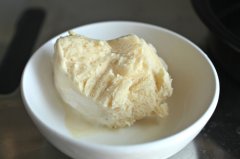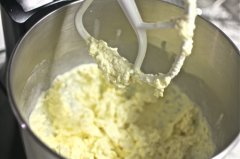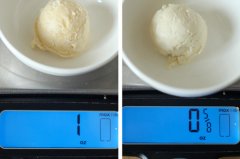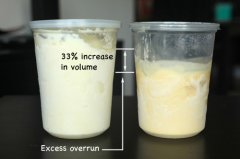Evaporated milk ice cream Recipes
 This ice cream is the real deal. [Photographs: J. Kenji Lopez- Alt]
This ice cream is the real deal. [Photographs: J. Kenji Lopez- Alt]
Like bicyclists who don't stop at stop signs and baths that aren't deep enough, unitasking kitchen tools are a major pet peeve of mine. Unfortunately a few of them* are absolutely required. Take the ice cream maker, for instance. Unless you want to sit whisking a bowl of custard over a salt and ice bath for a good half hour, there's no other way to make ice cream at home.
*Kitchen tools, not self-entitled bikers—who needs them?
Sure, I've seen the hacks, and I don't like any of 'em. There are the so-called "magic ice cream" recipes that have you fold whipped cream into an eggless base so that it doesn't form a solid block when you freeze it. There's a real name for fluffy stuff: it's called frozen mousse, and it's more akin to cool whip than real ice cream. I mean, it's called ice cream, not ice fluff, right? Ice cream needs to be dense, and it needs to be rich with egg yolks.
Then there are those recipes that simply take frozen fruit, mix it with a couple ingredients, and puree them in a food processor (bananas are a popular choice). These are better than the cool whip version, but they don't fool anyone: That's a thick smoothie, not ice cream.
 When I say ice cream, I mean the real deal: Ice cream that's rich, smooth and creamy on the spoon. Ice cream that melts slowly into a luscious, tongue-coating custard. The kind of badass ice cream that makes lesser people feel guilty for eating it. The kind of ice cream worth getting out of bed in the middle of the night for. I mean real ice cream.
When I say ice cream, I mean the real deal: Ice cream that's rich, smooth and creamy on the spoon. Ice cream that melts slowly into a luscious, tongue-coating custard. The kind of badass ice cream that makes lesser people feel guilty for eating it. The kind of ice cream worth getting out of bed in the middle of the night for. I mean real ice cream.
My goal this week: Keep the ice cream, lose the machine.
Breaking the Ice
My first test was destined to be a failure: I made a regular ice cream base by whisking 8 egg yolks with a cup of sugar, 2 teaspoons of vanilla extract, and a pinch of salt until it was pale yellow and ribbony. I then tempered it with 2 cups of hot heavy cream and 2 cups of hot milk. I cooked this base up to 180°F on the stove top, carefully whisking to avoid scrambling the eggs until it thickened into a glossy custard base.
Now normally, you'd chill this base and throw it into an ice cream machine to churn as it freezes. I decided to skip the machine, and throw it straight into the freezer to freeze on its own. A day later, and here's what I had:
You can clearly see that the ice cream base has formed large crystalline structures. Rather than feeling creamy on the tongue, it tasted icy and wet. It also took some major force to hack a piece out of the nearly solid block of frozen custard.
 So what exactly does churning accomplish? Well, as the ice cream freezes, its water component (milk and eggs are mostly water) has a natural tendency to form into large crystalline structures. Imagine the water molecules as individual blocks of Legos, and the freezer as an overzealous kid who really really wants to build them into a big castle.
So what exactly does churning accomplish? Well, as the ice cream freezes, its water component (milk and eggs are mostly water) has a natural tendency to form into large crystalline structures. Imagine the water molecules as individual blocks of Legos, and the freezer as an overzealous kid who really really wants to build them into a big castle.
Leave him to do his work, and the castle will be built in one large, tough-to-break structure. Churning the ice cream as it freezes prevents this structure from forming. Like trying to build a Lego castle in an earthquake, a few pieces may get stuck together, but not many.
So in order to make perfect ice cream, I'd need to figure out a way to either prevent these large crystals from forming, or to break them up after they do.
Easy, I thought. I'll just take that frozen brick of custard, cut it into pieces, throw it in the stand mixer, and churn it. As it slowly melts, the ice crystals should break up, then I can simply throw it back into the freezer and I'm good to go, right?

Wrong.
What I ended up with was not smooth and creamy ice cream, but something more akin to a wet concrete with shards of broken glass.
So breaking up the shards was a fail. I'd need to find a way to prevent the crystals from forming in the first place.
What kinds of things can hinder the formation of larger ice crystals? Sugar helps by physically getting in the way of the water molecules as they try and crystallize (that's why low-sugar ice cream recipes turn out such bad results). Similarly, fat and milk proteins help by stabilizing the mix so that some air can be incorporated, loosening up the structure.
Increasing the amount of sugar was not an option, but what about increasing the proportion of fats and proteins to water? What if I were to use evaporated milk in place of the regular milk? That should reduce the water content, thereby increasing the proportion of fat and protein without drastically affecting flavor.
It was an improvement—enough that I'd use evaporated milk in all of my ice cream (hacked or regular!) from now on. But it still needed lots of work.
Overriding Overrun
Churning also does another thing: it introduces air to the mix. The amount of air incorporated to the mix is referred to in the industry as overrun, and is given as a percentage representing the total volume after churning over the volume of the unchurned base.
So, for example, say I started out with 2 cups of ice cream base and introduced enough air to the mix while churning to make 3 cups of frozen ice cream. That's 50% more volume added during churning, so the ice cream has an overrun of 50%.
In small amounts, overrun is a good thing. It keeps the texture looser and creamier. Most premium ice creams, like Häagen-Dazs, have an overrun of about 25% while cheaper brands, like Breyers, can have an overrun of as much as 94%. At this level, the ice cream melts much faster, and loses a lot of its richness.





